 What is the difference between white flour and whole-wheat flour?
What is the difference between white flour and whole-wheat flour?
Is whole-wheat flour really healthier?
What about gluten-free flours?
It doesn’t take much to notice we live in a wide world of flours…and, as we enter the holiday baking season, we want to help clear up any “flour confusion” you may have, which is why we are making “flours” the
December Superfood of the Month!
White flour vs. whole-wheat flour
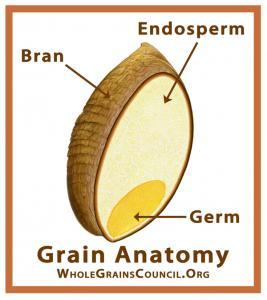 First, it’s helpful to understand that a wheat kernel contains three parts: the bran, the germ and the endosperm. The bran is the outer skin and contains beneficial antioxidants, B vitamins and fiber. The germ is on the inside of the kernel and contains B vitamins as well as protein, minerals and healthy fats. The endosperm is the “starchy” and largest portion of the kernel and contains the least amount of vitamins, minerals, and fiber.
First, it’s helpful to understand that a wheat kernel contains three parts: the bran, the germ and the endosperm. The bran is the outer skin and contains beneficial antioxidants, B vitamins and fiber. The germ is on the inside of the kernel and contains B vitamins as well as protein, minerals and healthy fats. The endosperm is the “starchy” and largest portion of the kernel and contains the least amount of vitamins, minerals, and fiber.
White (or all-purpose flour), as we all know, is light, fluffy and…white. White flour is a “refined grain” because the bran and germ have been removed, leaving only the less nutritious endosperm. When the endosperm is processed, the color that remains isn’t all that attractive. To deal with this, the flour is often bleached using chemicals such as chlorine and peroxide. This is what gives it the vibrant white color.
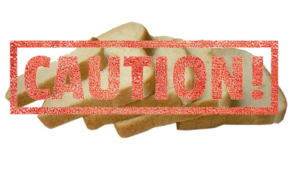 Removing the bran and germ can also lead to a variety of nutritional problems…this led the U.S. government to require that these refined grains be “enriched” by adding back nutrients such as thiamine, riboflavin and niacin.
Removing the bran and germ can also lead to a variety of nutritional problems…this led the U.S. government to require that these refined grains be “enriched” by adding back nutrients such as thiamine, riboflavin and niacin.
You may be wondering whether this “enrichment” makes white flour nutritionally the same as whole-wheat flour. Unfortunately, the enrichment doesn’t add back all the nutrients (like fiber) and the nutrients that are added back aren’t the same as those contained in the original bran and germ. Any time you see “enriched” on the ingredient label, that’s a red flag that the nutrients have been removed, and then some of them have been artificially added back in. (This applies to lots of processed foods, not just flours!)
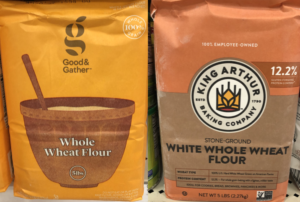 Whole-wheat flour, on the other hand, is higher in nutrients and fiber because all parts of the kernel (the bran, germ and endosperm) have been retained. Typically, whole-wheat flour is made from hard red wheat, which is why it is darker in color. White whole-wheat flour is made from hard white wheat, which explains its lighter color and its less strong wheat flavor. Both whole-wheat flour and white whole-wheat flour have the same nutritional value. Whole-wheat flour is NOT considered “enriched” and typically does not have additional nutrients added to it, which means it is more naturally nutritious than white flour.
Whole-wheat flour, on the other hand, is higher in nutrients and fiber because all parts of the kernel (the bran, germ and endosperm) have been retained. Typically, whole-wheat flour is made from hard red wheat, which is why it is darker in color. White whole-wheat flour is made from hard white wheat, which explains its lighter color and its less strong wheat flavor. Both whole-wheat flour and white whole-wheat flour have the same nutritional value. Whole-wheat flour is NOT considered “enriched” and typically does not have additional nutrients added to it, which means it is more naturally nutritious than white flour.
What is pastry flour?
Pastry flour is milled from a soft “summer” wheat berry, which contains a bit less gluten, making it lighter and fluffier. It is used for making “quick” baked goods, along with baking powder and baking soda, to result in tender light or crumbly, flaky pastries. (Be aware…because it contains less gluten, it does not work well to make yeast breads!) Pastry flour is also available in a whole-wheat version. And, white whole-wheat pastry flour is a favorite of ours for making quick bread, muffins and desserts.
What is the difference in gluten-free flours?
First, who benefits from gluten-free flours? If you have celiac disease or are “gluten intollerant,” then you must avoid grains containing gluten. Gluten is a protein found in wheat, rye and barley. Oats do not naturally contain gluten, but can be cross-contaiminated in processing. So, when you purchase oats, look for those labeled as “gluten-free.”
 Oat Flour: high in fiber, and easy to digest. It is super-simple to make your own. Oat flour is exactly how it sounds…rolled oats blended until they are a flour consistency. See how well in works in our Pumpkin Pancakes and Chocolate Chip Banana Bread.
Oat Flour: high in fiber, and easy to digest. It is super-simple to make your own. Oat flour is exactly how it sounds…rolled oats blended until they are a flour consistency. See how well in works in our Pumpkin Pancakes and Chocolate Chip Banana Bread.
- Rice Flour: made from finely milled rice, and comes in white and brown rice forms. High in fiber if made from brown rice, and works well in thickening soups, sauces and stews. It can also be used for baked goods and making pasta, and is a popular gluten-free option.
 Almond Flour: also known as almond meal, almond flour is packed with nutrients and favored by many because it doesn’t raise your blood sugar like grain flours do. You may find blanched or unblanched versions of almond flour — blanched just means that the almond skins have been removed, making the flour lighter in appearance. Some say that almond flour can make baked goods heavier, but it may depend on the recipe whether almond flour can be substituted for all-purpose or whole-wheat flour. We think almond flour works great in our Asian Salmon Cakes and Korean Kimchi Pancakes.
Almond Flour: also known as almond meal, almond flour is packed with nutrients and favored by many because it doesn’t raise your blood sugar like grain flours do. You may find blanched or unblanched versions of almond flour — blanched just means that the almond skins have been removed, making the flour lighter in appearance. Some say that almond flour can make baked goods heavier, but it may depend on the recipe whether almond flour can be substituted for all-purpose or whole-wheat flour. We think almond flour works great in our Asian Salmon Cakes and Korean Kimchi Pancakes.
- Coconut Flour: high in fiber, mild in flavor, and won’t spike your blood sugar like grain flours. When used in baking, coconut flour tends to absorb more water, so you may need to compensate by adding more liquid to the recipe.
- Tapioca Flour: also known as tapioca starch. It doesn’t contain a lot of nutrients, but is a good alternative to those looking for a gluten-free and nut-free option. Tapioca flour works well as a thickening agent in baking and cooking, such as pizza dough or pie filling. Try it in our Italian Breadsticks!
- Chickpea Flour (or Garbanzo Flour): very high in protein, fiber and other beneficial nutrients. Because of its versatile taste, texture, and binding power, chickpea flour works really well in baking and cooking.
- Gluten-Free Flour Blends: there are specially made blends of gluten-free flours that perform well and will improve your odds of successful baking. Unfortunately, most are not whole-grain, but search them out and you typically can find whole-grain versions.
What about flour made from sprouted grains?
Sprouted Flour is made from sprouted grains, such as spelt, amaranth, sorghum, rye, corn and more. Sprouted flour is a nutritional powerhouse because the grain is captured during its peak moment of “growth” or “sprouting.” This flour can be much easier to digest and easier to absorb vitamins and minerals. Sprouted flour can be made from sprouted wheat or from sprouted gluten-free grains.
How do you store flour?
All-purpose white flour can be stored at room temperature for 6-12 months…this is because it is less likely to go rancid with the bran and germ removed. Whole-wheat flour should only be stored at room temperature for about one month (which is not long!). Therefore, once purchased, it should be stored in an airtight container (or Ziploc plastic bag) in the refrigerator or freezer where it will last at least 6 months. If storing in the freezer, it is recommended to let the flour come to room temperature before using it because the cold temperature may affect other ingredients in your recipe. (We like to keep ours in the refrigerator so it is ready to grab and use immediately.) Gluten-free flours, once purchased, should also be stored in the refrigerator or freezer in airtight containers where they will last several months in the refrigerator and even longer in the freezer.
Which is best?
 The “best” option can vary depending on the food you are preparing and personal preferences. For our health, it is best to stick to whole-grains, which provide the most nutrients.
The “best” option can vary depending on the food you are preparing and personal preferences. For our health, it is best to stick to whole-grains, which provide the most nutrients.
Why whole-grains?
- They are higher in fiber because the bran and germ are not processed out.
- Whole-grain foods are digested more slowly, which will keep you feeling full longer.
- More nutrients than “enriched” foods.
- Whole-grains are not processed as a starch in our bodies, which means they are less likely to launch us into a sugar dependency cycle!
In our experience…
…with baked goods such as breads, muffins and cookies, we like to use white whole-wheat flour, whole-wheat pastry flour or oat flour. But, we have also had good results with many of the other gluten-free options, depending on the recipe. Shopping online at either Bob’s Red Mill or Hodgson Mill may make it a lot easier to find and try some of these flours.
Keep in mind, there are some recipes where simply replacing whole-wheat for all-purpose white flour may not produce good results (believe us, we have tried!).
A good rule of thumb: whole-wheat pastry flour and/or white whole-wheat flour can typically replace all-purpose white flour 100% in any “quick” bread recipe when used along with baking powder or baking soda. (Although, these flours do not work well in yeast breads, because they require a lot of gluten). And, if you have whole-wheat flour on hand, (not pastry flour), it can successfully be blended 50/50 with all-purpose flour in almost any recipe (with yeast or not).
We have excellent tried-and-true recipes using whole-wheat flour and gluten-free flour options like oat flour or almond flour. A few delicious examples include:
Glazed Lemon Chia Seed Muffins
Fruit-Topped Dutch Baby Pancake
Feel free to experiment and see which ones you like best, especially if you are trying different gluten-free or nut-free options!
 LEARN MORE ABOUT THE NAPKIN!
LEARN MORE ABOUT THE NAPKIN!
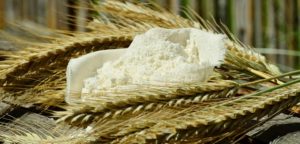
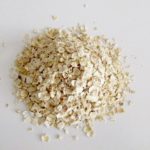
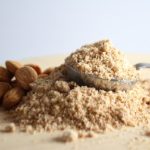
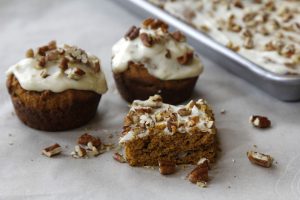
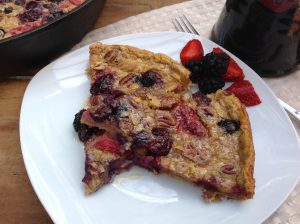
Leave A Comment